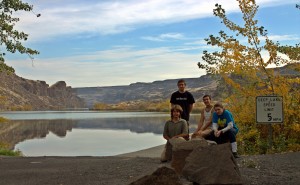Anonymous Field Notes
- The pothole is about 60 ft. in diameter and 40 ft. deep.
- The rocks are all basalt and seem to be organized by size. There are a section of small golf ball sized rocks, next to a section of gravel sized rocks next to an area filled with small boulders.
- There is vegetation around the rim and concentrated at the center where water pools.
- The flora include cheet grass, sage brushes, small shrubs and a few small green deciduous trees.
- At the bottom of the pothole there is a species of grass that is 4-5 ft. tall with broad leaves that we only encountered there.
- There is lots of lichen on the southern rock faces here because of the increased amount of shade
- The pothole has a secluded, peaceful feeling. It offers shelter on the otherwise inhospitable desert landscape.
- Large amount of vegetation in the center
- the sides are barren of wildlife leading up 10-15 feet towards the top
- most of the rocks in the pothole are of a medium size; half a foot to 1 and a half feet
- the north wall of the of the pothole is more sheer then the others
- on the east slope cheat grass grows in a cone towards the center stopping about 5 feet from it
- there are dead branches lying about fairly equally spaced around the pothole
- the pothole is south of deep lake
- no fauna except insects including flies beetles and bees
- soil is yellow, fine grained, and dry
Brylie Oxley’s Field Notes
9:15 we set out from Dining Hall
I felt eager to start getting a sense of this huge environment. We headed Southeast towards Deep Lake and the potholes.
12:00 we eat a packed lunch at Deep Lake
Deep lake is placid and clear. We walk out on the dock and look down into the weeds growing in the water. Someone spots a fish, perhaps a trout?
We eat lunch on a picnic bench nearby the water. We soon decide it is time to continue our search for the giant potholes.
12:30 A false alarm, large ravine, not a pothole
As we continue onward, we scale a wall and find a great opening emerging before us. The depth is probably on the order of 40-60 feet. This may be a pothole. When we walk down into the ravine, we notice that it is not entirely closed, and the Deep Lake valley opens again before us.
1:07 we find a pothole
the pothole is immense. The sheer force it must have taken to drill into the basalt bedrock. I am imagining being ~800 feet below the surface, while a huge water tornado drills into the ground before me.
Sounds: crows, distant hum
Crows caw at one another, hundreds of feet across the canyon. Another type of bird, perhaps a hawk, makes occasional descending calls, while a warbling call can be heard nearer the water.
The faint drone of vehicles can be heard in the distance. A distant thunder sounds.
I follow the bird calls to a new vantage point overlooking Deep Lake.
Skimming water birds
Two water birds skimming along the surface of the lake. I am not sure if these are the source of the call that drew me over.
Sheer rock
Eastward, the edges of the lake are framed by sheer cliffs approximately 200-400 feet tall. How were these cliffs carved? Was it also the superfloods? Why do they not exhibit the same chiseled erosion as surrounding rocks? What geologic time span separates the formation of the visible layers?
West wind
The wind picks up from the west. It carries with it the chill of the distant thunderstorm. It must be following the same contours, eddies, whorls, etc. that water would follow as it cascaded through this canyon.


